
Are you struggling to find the perfect keywords to help your website rank higher in search engines?
If you’re a content creator or marketer, you know that finding the right keywords can make a world of difference. But with so many keywords out there, it can be challenging to know where to start. That’s where long-tail keywords come in.
What Are Long-tail Keywords?
Long-tail keywords are usually well-thought-out queries in the form of questions, phrases, and sentences, typically three or more words long.
The term “long-tail” refers to the “long-tail” of a search’s demand curve. As queries around a topic become more specific, the search volume decreases while the likelihood of conversion increases.
Simply, long-tail keywords are specific, longer phrases that users search for and often have lower search volume than generic keywords.
For example, let’s say you have a website that sells running shoes.
A generic keyword like “running shoes” would have a high search volume but high competition. A long-tail keyword like “best running shoes for women with high arches” would have a lower search volume but less competition, making it easier to rank.
However, these keywords can make up a significant portion of website traffic when used effectively and can be a game-changer for your SEO.
Why Are Long-Tail Keywords Important for SEO?
In the world of SEO, long-tail keywords play a crucial role in driving targeted traffic to your website. While generic keywords like “shoes” or “books” may have high search volume, they’re also highly competitive, making it difficult to rank on the first page of search results.
Long-tail keywords, on the other hand, are less competitive and more specific, making it easier to rank for them.
56 percent of buyers who search use queries of three or more words, while only 7 percent use one word or an acronym.
So, if you’re not using long-tail keywords in your SEO strategy, you’re missing out on a massive opportunity to drive targeted traffic to your website.
Why Do You Need Long-Tail Keywords In Your SEO Strategy?
Using long-tail keywords in your content can help you rank higher in search engines, drive targeted traffic to your website, and increase your chances of converting visitors into customers.
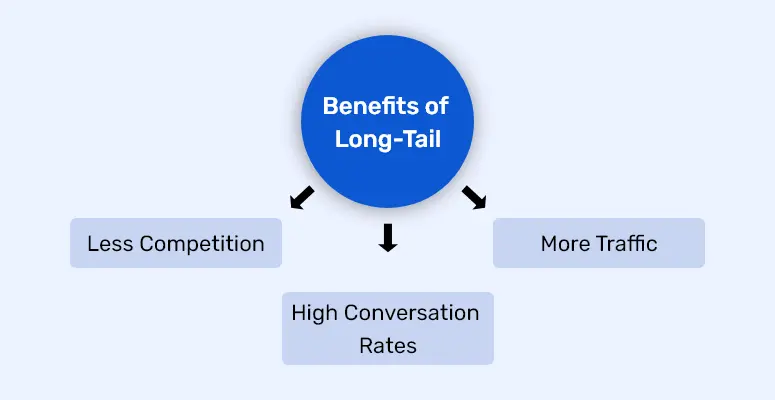
Here are some reasons why long-tail keywords are essential for your SEO strategy:
There is less competition: Long-tail keywords are less competitive than generic keywords, thus easier to rank in search engines.
They bring higher conversion rates: Long-tail keywords are more specific, implying that users who search for them are often closer to making a purchase. This makes them more likely to convert into customers.
There is more targeted traffic: Long-tail keywords are more specific, which means that users who search for them are more likely to be interested in your product or service. This approach will help you drive more targeted traffic to your website.
Why Are Long-Tail Keywords Better Than Short-Tail Keywords?
Since we are understanding the ins and outs of long-tail keywords, let’s see how long-tail keywords beat short-tail keywords.
Short-tail keywords are usually one or two words in length while long-tail keywords are typically three or more words. While both types of keywords have their place in SEO and content creation, there are distinct differences between the two.
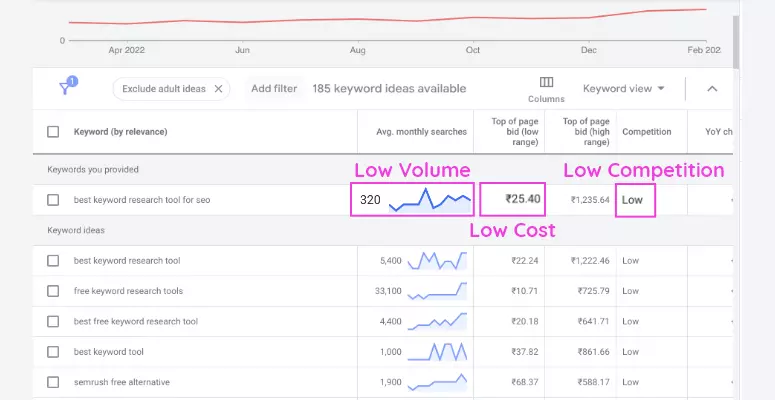
Search Volume:
short-tail keywords tend to have a higher search volume than long-tail keywords, which means that more people are searching for the short-tail keyword, making it more competitive to rank.
On the other hand, long-tail keywords have a lower search volume but are more specific, making them easier to rank for.
For example, let’s say you have a website that sells shoes. The keyword “shoes” would be a short-tail keyword with a high search volume, while “women’s running shoes” would be a long-tail keyword with a lower search volume.
Competition:
As mentioned earlier, short-tail keywords are more competitive due to their higher search volume. It can be more difficult to rank for these keywords, as many other websites are likely targeting the same keywords.
Long-tail keywords, on the other hand, have less competition, making it easier to rank for them.
For example, if you search for “SEO” on Google, you’ll see over 5 billion results. However, if you search for “how to optimize your website for SEO,” you’ll see that there are merely a few hundred thousand results.
Conversion Rates:
Long-tail keywords are generally more effective in driving conversions because they are more specific to what the user is looking for.
When someone types in a long-tail keyword, they are typically looking for something very specific, which means they are more likely to make a purchase or take some other desired action.
For example, if someone searches for “shoes,” they could be looking for anything from dress shoes to running shoes to sandals.
But if they search for “women’s running shoes,” they are clearly looking for a specific type of shoe and are more likely to make a purchase if they find what they’re looking for on your site.
Cost:
short-tail keywords are generally more expensive to bid on in paid search advertising, such as Google Ads as they have a higher search volume and more competition.
Long-tail keywords, on the other hand, are typically cheaper to bid on because they have a lower search volume and less competition.
While short-tail keywords may have a higher search volume and more visibility, they also have more competition and can be more expensive.
Long-tail keywords may have a lower search volume, but they are more specific, have less competition, and can be more effective in driving conversions.
The best approach is to use a combination of short-tail and long-tail keywords in your SEO and content strategy to maximize your reach and impact.
Strategies For Finding Long-Tail Keywords
Let’s discuss all the best way to find long tail keywords. There are some un-told tips and tricks for finding long tail keywords using Google Keyword Planner. Let’s dive into that.
Look At Your Competitors:
Starting with strategies, competitor research can save you from spending long hours analyzing long-tail keywords. You can sign-in tools like Ahrefs, Serpple, or SEMrush to analyze your competitor’s websites and see what keywords they’re targeting.
Here, you can look for long-tail keywords that competitors are ranking for and consider creating content around those keywords.
One thing to note is that you shouldn’t simply copy your competitors’ keywords. Instead, use their keyword research as a starting point for your own research.
Additionally, look for gaps in your competitors’ content and consider creating content around those topics.
You can find Competitor keywords using Google Keyword Planner with the “Discover New Keywords” section, see how:
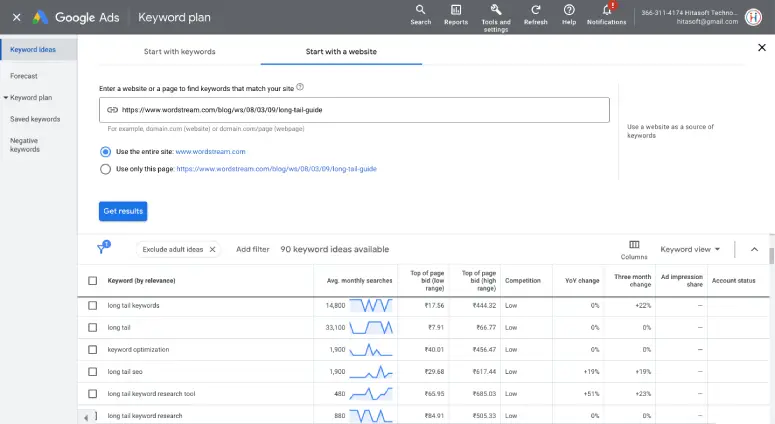
Use Google Autocomplete:
Google Autocomplete is a feature that suggests search queries as you type in the search bar. When you start typing in a keyword related to your niche, you can see what suggestions come up.
However, Google Autocomplete may not provide a complete picture of what keywords users are using to find your website as Google generally personalizes Autocomplete suggestions based on your previous search history. To get a broader picture of long-tail keywords, it may be helpful to use other keyword research strategies.
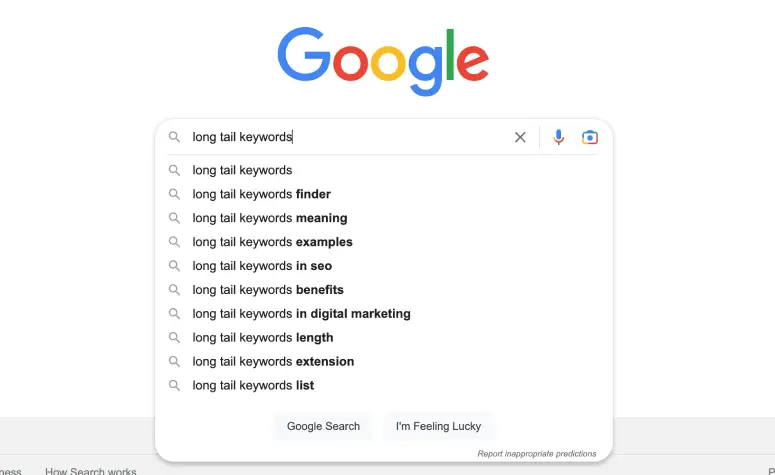
Use Keyword Research Tools:
Keyword research tools like Serpple can be great resources for finding long-tail keywords. It provides users with data on keyword search volume, competition, and difficulty, as well as suggestions for related keywords and phrases.
Serpple also offers a keyword tracking feature, which allows users to monitor their website’s search engine rankings for specific keywords over time. The tool is designed to be user-friendly and accessible to both beginners and experienced marketers.
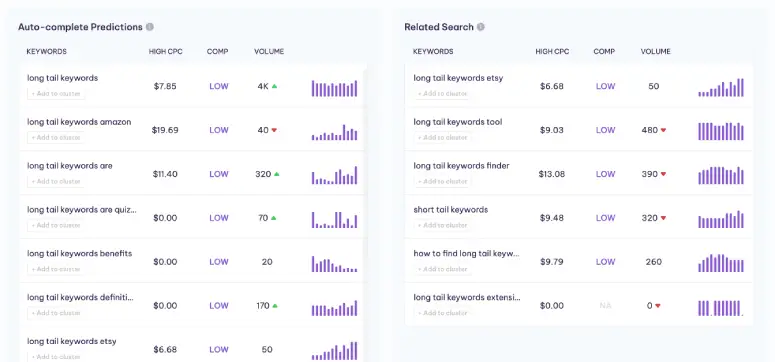
Google Others Want To Know:
Using Google’s “Others want to know” feature to find long-tail keywords can be a useful strategy. The “Others want to know” feature provides related search queries relevant to your original search query.
By exploring these queries, you can uncover new long-tail keywords you may not have considered otherwise. The questions in the “Others want to know” section can give you insight into what users are searching for and what information they’re looking to find, creating more relevant and targeted content that meets the needs of your audience.
Using long tail keywords from the “Others want to know” section can help you create more focused and relevant content that addresses specific questions and concerns of your audience.
Thus, it can lead to higher engagement, better SEO, and an overall improvement in your content strategy.
The related queries in the “Others want to know” section can help you identify new topics and areas of interest that you may not have considered before.
You can expand your content strategy and attract new audiences to your website.
Using Google’s “Others want to know” feature to find long-tail keywords can be a valuable strategy for improving your digital marketing efforts and reaching your target audience more effectively.
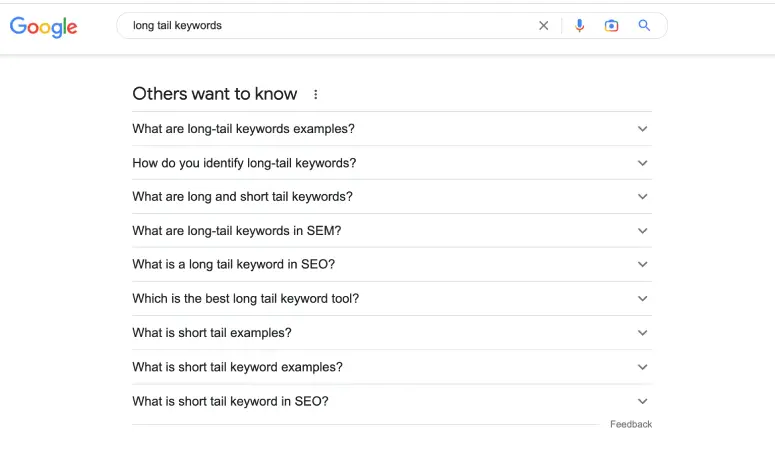
Google Related Search:
By using Google-related search, you can refine your search and get more specific results related to your niche or industry. This can save you time and effort, as you don’t have to sift through irrelevant results.
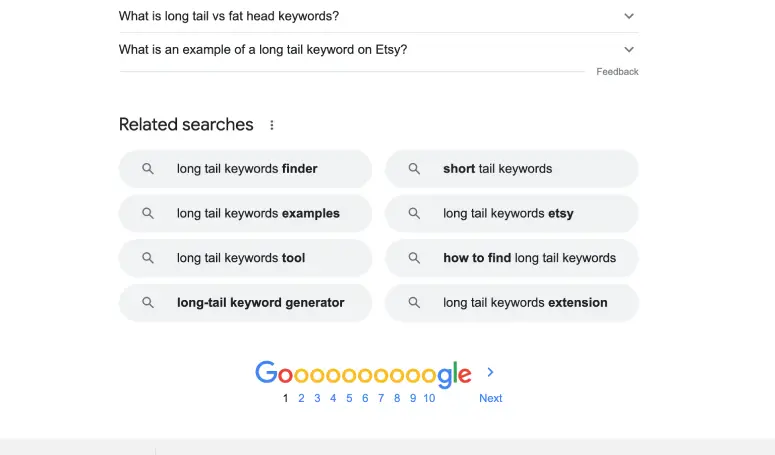
Expert Tip:
How to do long tail keyword research? Free Tool or Paid Tool? Is there any free long tail keyword research option available?
Yes! & It’s simple!
Here’s an exclusive trick that’s completely free and not widely discussed online. It’s a simple technique using Google Keyword Planner and worth trying out now. See the instructions below.
Using Google Keyword Planner:
Google Keyword Planner is a powerful tool for finding long-tail keywords. Most of the SEOs wouldn’t have tried this. Yes! Its a hidden diamond in the rough. Follow these steps.
Step 1: Sign in to your Google Ads account and navigate to the Keyword Planner tool.
Step 2: Select “Discover new keywords.”
Step 3: Enter a few relevant short keywords or phrases related to your topic in the “Your product or service” box and add “+” with any question words such as how, why, what etc.
Step 4: In the “Targeting” section, select your target language, location, and any other relevant options.
Step 5: Click “Get Results.”
Bingo! You will get some long tail question keywords. Review the list of suggested keywords and sort them by relevance, search volume, or other criteria that are important to you.
Look for long-tail keywords that are more specific and have lower competition. These keywords typically have lower search volume but can be more targeted and easier to rank for.
Add the long tail keywords to your content or ad campaigns as appropriate.
Remember to focus on the relevance of the keywords to your topic and audience, rather than just their search volume.
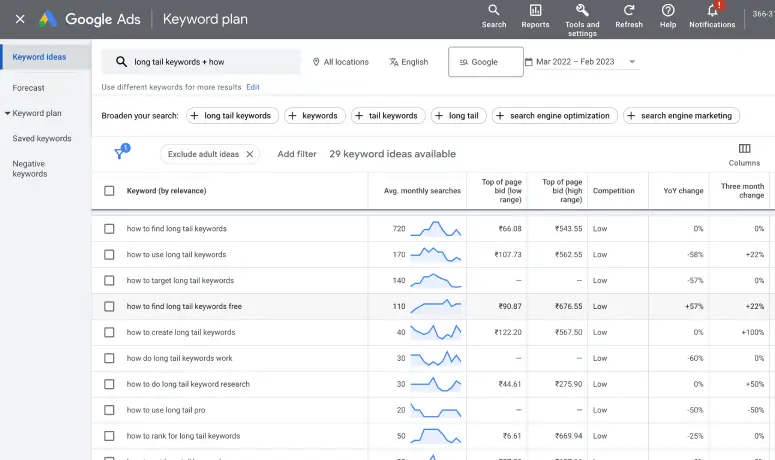
The power question words that can help to identify the long tail question keywords are given here in the following picture. You can use them on Google directly or it’s Keyword Planner.

Check Your Analytics:
One of the most valuable sources of information for finding long-tail keywords is your own website’s analytics data.
By analyzing the search terms that users are using to find your website, you can identify potential long-tail keywords you may not have considered.
This can provide insights into the specific questions, topics, and phrases your audience is interested in and help you create more targeted and relevant content.
Google Analytics is a well-known tool for tracking website traffic and analyzing user behavior.
To mine your analytics for long-tail keyword ideas, go to the “Search Console” section in Google Analytics and look at the queries driving traffic to your website.
You can also use the “Site Search” feature to see the terms that users search for on your website.
In addition to Google Analytics, other analytics tools can provide valuable keyword data. For example, Clicky and Kissmetrics are two tools that offer keyword analysis and tracking features.
By analyzing your website’s analytics data, you can uncover hidden long-tail keyword opportunities and improve your content strategy to meet the needs of your audience better.
How To Use Long-tail Keywords?
Once you’ve identified some long-tail keywords, use them effectively in your content.
Using long-tail keywords in your content can significantly impact your website’s traffic and search engine ranking.
Here are the best practices on how to incorporate long-tail keywords into your content:
Use Long-Tail Keywords Naturally
When it comes to using long-tail keywords in your content, to use them naturally. Don’t force them in or use them too frequently, as this can come across as spammy.
Instead, try to incorporate them in a way that flows naturally with the rest of your content.
For example, let’s say you’re writing a blog post about “best hiking boots for women.” Rather than stuffing your content with the exact phrase “best hiking boots for women,” you could use related long-tail keywords like “top-rated hiking boots for women” or “most comfortable women’s hiking boots.”
Use The Keywords In Your Headlines
Using long-tail keywords in your headlines can help your content rank higher in search engines and make it more appealing to users.
Your headlines should accurately reflect the content of your article, and incorporating long-tail keywords can help you achieve this.
For example, instead of using a generic headline like “Hiking Boots for Women,” you could use a more specific and keyword-rich headline like “Top-Rated Hiking Boots for Women: Comfortable and Durable Options.”
Use Long-Tail Keywords In Your Meta Descriptions
Meta descriptions are the short snippets that appear under the page title on search engine results pages (SERPs).
Using long-tail keywords in your meta descriptions can help improve click-through rates and give users a better idea of what your content is about.
For example, let’s say you’re writing a blog post about the benefits of drinking green tea.
Your meta description could read something like this: “Discover the Health Benefits of Green Tea: Boost Your Metabolism and Reduce Stress.”
Alt Tags Are Also A Great Way
Alt tags are used to describe images on your website to search engines and visually impaired users. Using long-tail keywords in your alt tags can help improve your website’s accessibility and make it easier for users to find your content.
For example, let’s say you have an image of a woman wearing hiking boots on your website.
Instead of using a generic alt tag like “hiking boots,” you could use a more specific alt tag like “top-rated hiking boots for women.”
Don’t Overuse Long-Tail Keywords
While using long-tail keywords in your content is crucial, it’s equally important not to overuse them.
Focus on creating high-quality content that provides value to your users, and use long-tail keywords to support your content.
For example, let’s say you’re writing a blog post about the benefits of green tea. Instead of using the phrase “benefits of green tea” in every other sentence, use related long-tail keywords like “health benefits of green tea” or “green tea for weight loss” to provide variety in your content.
In conclusion, using long-tail keywords in your content can be a game-changer when it comes to improving your website’s visibility and attracting the right audience.
By using them naturally, in your headlines, meta descriptions, and alt tags, and without overusing them, you can create high-quality content that is both valuable to your users and optimized for search engines.
The Bottom Line
As we wrap up our discussion on how to find the best long-tail keywords for your website or blog, it’s important to remember that there is no one-size-fits-all solution.
Every niche and industry has its own unique set of challenges and opportunities, and it’s up to you to find the keywords that work best for your particular audience and goals.
One thing is for sure: if you want to succeed in the world of online marketing, you can’t afford to ignore the power of long-tail keywords.
These specific and focused search terms may not have the highest search volume, but they can be incredibly effective at driving targeted traffic to your site and helping you achieve your desired conversions.
The strategies we’ve discussed in this blog post are just the tip of the iceberg when it comes to finding long-tail keywords.
There are many other tactics and tools you can use, from competitor research to social listening to user-generated content analysis.
But no matter which approach you take, the key is to stay curious, stay persistent, and always be on the lookout for new opportunities to improve your keyword research and content marketing efforts.
As the digital landscape continues to evolve, the importance of effective keyword targeting will only increase, so it’s important to stay ahead of the curve.
Finding the perfect long-tail keywords for your website or blog may seem like a daunting task, but with the right mindset and tools, it’s definitely achievable.
By staying focused on your niche, understanding your audience’s needs and intent, and using a combination of research methods and rank tracker, you can create content that resonates with your target market and drives real results for your business.
So don’t be afraid to dive in and start experimenting today – who knows where it might take you?
Khyati Arora
Posted on March 16, 2023
Khyati Arora is a Journalism Graduate with a flair for creating actionable content. She believes that great content drives actions and helps businesses be more influential. She finds ultimate joy when writing about new trends in the marketing domain. Also, she loves to travel and going to new places.




